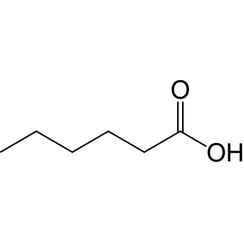You have no items in your shopping cart
Hexanoic acid
Hexanoic acid, also known as caproic acid, is the carboxylic acid derived from hexane with the chemical formula CH
3(CH
2)
4COOH. It is a colorless oily liquid with an odor that is fatty, cheesy, waxy, and like that of goats[1] or other barnyard animals. It is a fatty acid found naturally in various animal fats and oils, and is one of the chemicals that gives the decomposing fleshy seed coat of the ginkgo its characteristic unpleasant odor. It is also one of the components of vanilla. The primary use of hexanoic acid is in manufacture of its esters for artificial flavors, and in the manufacture of hexyl derivatives, such as hexylphenols. Salts and esters of hexanoic acid are known as hexanoates or caproates.
Two other acids are named after goats: caprylic (C8) and capric (C10). Along with hexanoic acid, they account for 15% of the fat in goat's milk.
Caproic, caprylic, and capric acids (capric is a crystal- or wax-like substance, whereas the other two are mobile liquids) are not only used for the formation of esters, but also commonly used "neat" in: butter, milk, cream, strawberry, bread, beer, nut, and other flavors.


